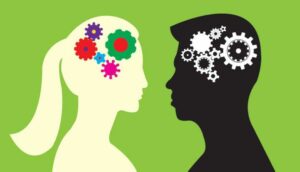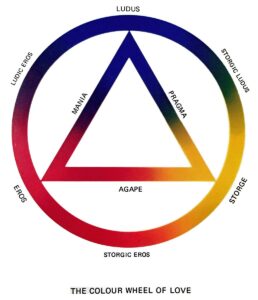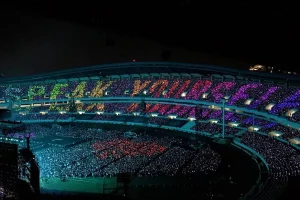Love has many different dimensions and is experienced uniquely by each individual, but it is a fundamental human experience. It is an intense emotion that can be felt in so many different ways, and subsequently, it is also communicated in a variety of ways. There are so many aspects of our life that are going to alter how we view love such as our beliefs/values, culture, personality, and even past experiences. However, one factor that especially attributes to the different ideas of love and its expression is gender.

Scientifically, the difference between men and women can be accredited to one chromosome – the Y chromosome. The presence of, or lack of, this chromosome determines what our gender is going to be, and thus sets the basis for our different biological makeup. We have different anatomy, hormones, and thought processes. It only makes sense that because of these distinctions we will also love differently, and this can be seen through how men and women communicate love. Due to our nature, women are more likely to seek more of a nurturing type of love, whereas men tend to seek passion: “women would conceptualize love in terms of its nurturant varieties, namely companionate kinds of love, whereas men would conceptualize love in terms of non-nurturant varieties, namely passionate kinds of love”. 1

However, while biology set the precedent for making women and men who they are, social and cultural factors have since molded them into what they are today. There are many stereotypes that contribute to the role that men and women are expected to fulfill in matters of romantic love, and they affect how men and women perceive romantic relationships today. There is a common conception that men tend to care about the sexual aspects of a relationship while women care about the emotional. Women are expected to to be nurturing, motherly, submissive, and vulnerable with their partners. Conversely, men are expected to be stoic, providers, dominant, and the primary caretakers. From a young age, society implements this mindset socializing girls and boys which results in gender roles possessing the power to construct how they will then go on to view love. These perceptions, while representative of how gender usually impacts relationships, doesn’t account for those men and women who do not conform to a specific stereotype: “Emotions such as love tend to be experienced as uniquely personal events, so that the very idea that social forces… might have shaped the form of one’s love seems like an infringement of personal liberty”. 2Having this mindset leaves little room for understanding some of the other facets that make love a unique experience for each and every individual and can even further contribute to gender roles.
To approach the idea of love with a better understanding of why it differs for each emotional being we must understand its complexity. Love cannot be defined in one simple term, and there is not just one kind of love. There are many embodiments of it such as the love you have for your family, the love you have for nature, the love you have for your friends, love you have for God, and love you have for a romantic partner. Therefore, because there are different types of love there are going to be different ways to express this feeling both verbally and non-verbally. Gary Chapman who has had extensive experience as a couple’s counselor, recognized this and devised a toolkit for understanding these different styles of communication. Within his book, he identifies 5 different love languages: Acts of service, gift giving, quality time, physical touch and words of affirmation. 3 There is a profile available with questions for both men and women to be able to identify their own love language. This knowledge could serve to be useful in the success of future relationships. Click here to find out your love language.

Words of affirmation tend to typically come easily to women because verbal expression of emotions involve having to be vulnerable with your partner, and men find it easier to lead through action. This does not necessarily mean that men do not communicate their love for their partner verbally, it just means that they are more than likely to not use as much emotional vocabulary as women. In the case of acts of service, some general examples of how men communicate this is by fixing things or providing for the household, while women tend to cook or clean as their forms of service. For the language of physical touch, men are more likely to crave intimacy like kissing or sexual acts, while women tend to appreciate cuddling or holding hands as intimacy. Quality time for men is spent doing just about any activity together, and women tend to seek valuable time that requires emotional connectedness. While gift giving is a love language that is common in both genders, women tend to seek gifts that are of sentimental value, and men enjoy the practicality of a gift.
Everyone has their own preferred way of showing love and receiving it, and while the differences between the nature in which men and women show love is not as exaggerated as the stereotypes make them out to be, there were still differing features.
Although, it can be common for men and women to share the same love language, it is important to recognize other interpretations of that same language, and in doing so we can better understand our partners. Gender differences in communication styles occur mostly because “men are perceived as less expressive and less emotional, and women are perceived as more emotional, sensible, easily susceptible to feelings”. 4 There is also a possibility that because outright expression of emotion is not typically viewed as “masculine”, men may hold back from truly expressing their feelings. As a result, there is an imbalance of transparency in these relationships with one partner craving emotional connectedness through words, and the other withholding it: “In a mysterious way, the giving or withholding of emotion and intimacy thus becomes one kind of ‘carrier’ of gender power”. 5
In addition to the five love languages, another way to see the differences in how men and women view love is to take a look into the different love styles: eros ludus, storge, mania, pragma, and agape. Eros is love involving romance, ludus is game-playing love, storge is platonic, mania tends to be obsessive, pragma is logical love, and agape is a selfless type of love. 6 Women tend to exhibit more of the pragmatic approach to love by being very careful when the opportunity of a new relationship arises. Men tend to be very quick to experience emotions of love and enjoy the spontaneity of new relationships, which fall in line with the ludus style of love. This would also explain why men deem to be more action-oriented rather than verbally committed to expressing their feelings. Women also tend to have a storgic style of love because of their desire to reach a deeper level of connectedness, they seek companionship. However, they also tend to exude a more manic style of love in comparison to their male counterparts being more obsessive, controlling and anxious in relationships.

Overall, love is an experience so subjective and unique to the beholder that it’s hard to pinpoint just one contributor to why people express love in different ways. Amongst some of the reasons are personality, social norms, culture, background, experiences, and finally, gender. While the differences are more subtle than one would expect in comparison to modern day stereotypes, it has an effect on the type of love style you are likely to have and in turn how you are going to develop a language to communicate that love. The significance of understanding this dynamic between genders and romantic relationships will allow us to learn more about ourselves, but also learn how to love our partners in the language that they know how to love.
- Fehr, Beverley, and Ross Broughton. “Gender and personality differences in conceptions of love: An interpersonal theory analysis.” Personal Relationships 8, no. 2 (2001): 115-136. ↵
- Duncombe, Jean, and Dennis Marsden. “Love and Intimacy: The Gender Division of Emotion andEmotion Work’ A Neglected Aspect of Sociological Discussion of Heterosexual Relationships.” Sociology 27, no. 2 (1993): 221-241. ↵
- Chapman, Gary D., and Gary Chapman. The five love languages: The secret to love that lasts. Oasis Audio, 2005. ↵
- Barbara, Gawda. “Gender differences in the verbal expression of love schema.” Sex roles 58 (2008): 814-821. ↵
- Duncombe, Jean, and Dennis Marsden. “Love and Intimacy: The Gender Division of Emotion and Emotion Work’ A Neglected Aspect of Sociological Discussion of Heterosexual Relationships.” Sociology 27, no. 2 (1993): 221-241. ↵
- Hendrick, Clyde, Susan Hendrick, Franklin H. Foote, and Michelle J. Slapion-Foote. “Do men and women love differently?.” Journal of Social and Personal Relationships 1, no. 2 (1984): 177-195. ↵



1 comment
Samantha Aragon
Hi Karina, I really enjoyed reading your article. Your article did a great job of doing an in-depth exploration of how one’s identified gender can play a role in how love is expressed. In particular, I was excited to learn about the different styles of love, as I had never heard of these before. This article was easy to read, clearly communicated, and had a great narrative flow. I think it would be interesting to look into different statistics regarding this topic, such as how many people are aware of gender’s role in love expression or if love languages are utilized in relationship counseling.